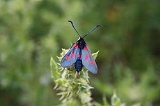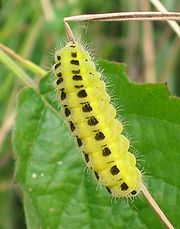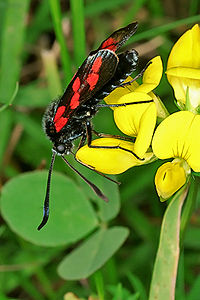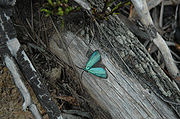
Zygaenidae
Encyclopedia


Moth
A moth is an insect closely related to the butterfly, both being of the order Lepidoptera. Moths form the majority of this order; there are thought to be 150,000 to 250,000 different species of moth , with thousands of species yet to be described...
s are a family of Lepidoptera
Lepidoptera
Lepidoptera is a large order of insects that includes moths and butterflies . It is one of the most widespread and widely recognizable insect orders in the world, encompassing moths and the three superfamilies of butterflies, skipper butterflies, and moth-butterflies...
. The majority of zygaenids are tropical, but they are nevertheless quite well represented in temperate regions. There are about 1000 species. Various species are commonly known as Burnet or Forester moths, often qualified by the number of spots, although other families also have 'foresters'. They are also sometimes called Smoky moths.
All 43 species of Australian zygaenids are commonly known as foresters and belong to the tribe Artonini of the subfamily Procridinae. The only non-endemic species in Australia is Palmartona catoxantha, a Southeast Asian pest species which is believed to be already present in Australia or likely to arrive soon
Description
Zygaenid moths are typically day-flying with a slow fluttering flight, and with rather clubbed antennaAntenna (biology)
Antennae in biology have historically been paired appendages used for sensing in arthropods. More recently, the term has also been applied to cilium structures present in most cell types of eukaryotes....
e. They generally have a metallic sheen and often prominent spots of red or yellow. The bright colours are a warning to predators that the moths are distasteful - they contain hydrogen cyanide (HCN) throughout all stages of their life-cycle. Unlike most insects with such toxins, they obtain glucosides from feeding on Birds-foot Trefoil (Lotus
Lotus (genus)
Lotus is a genus that includes bird's-foot trefoils and deervetches and contains many dozens of species distributed world-wide. Depending on the taxonomic authority, roughly between 70 and 150 are accepted. Lotus is a genus of legume and its members are adapted to a wide range of habitats, from...
) so that they, themselves can use HCN as a defense. However, they are capable of making HCN themselves, and when in an environment poor in cyanide-producing plants, synthesize it themselves, http://www.sciencenews.org/view/generic/id/72669/title/Plants_and_predators_pick_same_poison. They are known to have mimicry complexes based on these toxins.
Larvae are stout and may be flattened. A fleshy extension of the thorax covers the head. Most feed on herbaceous plants, but there are some tree-feeders. Larvae in two subfamilies, Chalcosiinae and Zygaeninae, have cavities in which they store the cyanide, and can excrete it as defensive droplets.
Selected taxa

Incertae sedis
, is a term used to define a taxonomic group where its broader relationships are unknown or undefined. Uncertainty at specific taxonomic levels is attributed by , , and similar terms.-Examples:*The fossil plant Paradinandra suecica could not be assigned to any...
include:
- AcoloithusAcoloithusAcoloithus is a genus of moths of the Zygaenidae family.-Species:* Acoloithus falsarius Clemens, 1860* Acoloithus novaricus Barnes & McDunnough, 1913* Acoloithus rectarius Dyar, 1898-References:*...
- HarrisinaHarrisinaHarrisina is a genus of moths of the Zygaenidae family.-Species:* Harrisina americana – Grapeleaf Skeletonizer * Harrisina aversus Harrisina is a genus of moths of the Zygaenidae family.-Species:* Harrisina americana – Grapeleaf Skeletonizer (Guérin-Méneville, [1832])* Harrisina aversus...
- PyromorphaPyromorphaPyromorpha is a genus of moths of the Zygaenidae family.-Species:* Pyromorpha caelebs Blanchard, 1972* Pyromorpha centralis * Pyromorpha contermina * Pyromorpha correbioides...
- ReissitaReissitaReissita simonyi, the Arabian Burnet Moth, is a species of diurnal moth of the Zygaenidae family. It is the only species from the genus Reissita, and native to the southern part of the Arabian Peninsula. It resembles some species from the related genus Zygaena, and like them Reissita simonyi is...
- SerydaSerydaSeryda is a genus of moths of the Zygaenidae family.-Species:* Seryda anacreon * Seryda basirei * Seryda cincta Walker, 1856* Seryda constans * Seryda thyana -References:...
- TetracloniaTetracloniaTetraclonia is a genus of moths of the Zygaenidae family.-Species:* Tetraclonia cinniana * Tetraclonia dyaria Jordan, 1913* Tetraclonia forreri * Tetraclonia latercula...
- TriprocrisTriprocrisTriprocris is a genus of moths of the Zygaenidae family.-Species:* Triprocris smithsoniana * Triprocris yampai Barnes, 1905-References:*...
Pest
Pest (animal)
A pest is an animal which is detrimental to humans or human concerns. It is a loosely defined term, often overlapping with the related terms vermin, weeds, parasites and pathogens...
species include:
- Almond-tree leaf skeletonizer moth (Aglaope infausta)
- Vine bud moth (Theresimima ampellophaga)
- Grapeleaf Skeletonizer (Harrisina americana)
10 Species are found in the UK:
- Scarce Forester (Adscita globulariae)
- Cistus Forester (Adscita geryon)
- Forester (Adscita statices)
- Scotch BurnetZygaena exulansThe Mountain Burnet, Zygaena exulans, is a moth of the Zygaenidae family.This species exist in mountainous areas in Central Europe, Scotland, Scandinavia and Northern Russia....
(Zygaena exulans) - Slender Scotch BurnetZygaena lotiZygaena loti is a member of the Zygaenidae family....
(Zygaena loti) - New Forest BurnetZygaena viciaeZygaena viciae is a member of the Zygaenidae family....
(Zygaena viciae) - Six-spot BurnetSix-spot BurnetThe Six-spot Burnet, Zygaena filipendulae, is a day-flying moth of the family Zygaenidae. It is a common species throughout Europe....
(Zygaena filipendulae) - Five-spot BurnetZygaena trifoliiThe five-spot burnet is a moth in the family Zygaenidae....
(Zygaena trifolii) - Narrow-bordered Five-spot Burnet (Zygaena lonicerae)
- Transparent Burnet (Zygaena purpuralis)
African species include:
- Fire Grid BurnetFire Grid BurnetThe Fire Grid Burnet is a day-flying moth of the family Thyrididae. It is found in Zimbabwe and Malawi to Mozambique and South Africa....
(Arniocera erythopyga)
Extinct species include:
- Neurosymploca? oligocenicaNeurosymploca? oligocenicaNeurosymploca? oligocenica is an extinct species of moth in the family Zygaenidae, and possibly in the modern genus Neurosymploca. The species is known from Early Oligocene, Rupelian stage, lake deposits near the commune of Céreste in the Alpes-de-Haute-Provence, France.-History and...
Fernández-Rubio & Nel, 2000 (Lower StampianRupelianThe Rupelian is, in the geologic timescale, the older of two ages or the lower of two stages of the Oligocene epoch/series. It spans the time between and . It is preceded by the Priabonian stage and is followed by the Chattian stage....
, CéresteCéresteCéreste is a commune in the Alpes-de-Haute-Provence department in southeastern France.-History:A Gallo-Roman period settlement was established in the quarter of today's Saint-Sauveur priory, possibly as a crossing control point for the river...
, Alpes-de-Haute-ProvenceAlpes-de-Haute-ProvenceAlpes-de-Haute-Provence is a French department in the south of France, it was formerly part of the province of Provence.- History :Nord-de-Provence was one of the 83 original departments created during the French Revolution on 4 March 1790...
, France)
- See also list of zygaenid genera
External links
- List of Zygaenidae Types, p. 8-11 (Museum Witt München).
- Moths and Butterflies of Europe and North Africa - Zygaenidae - lots of pictures of species
- Family Zygaenidae at Lepidoptera.pro
- Science News: Zygaenidae "make cyanide using the exact same cellular machinery as their host plants"

